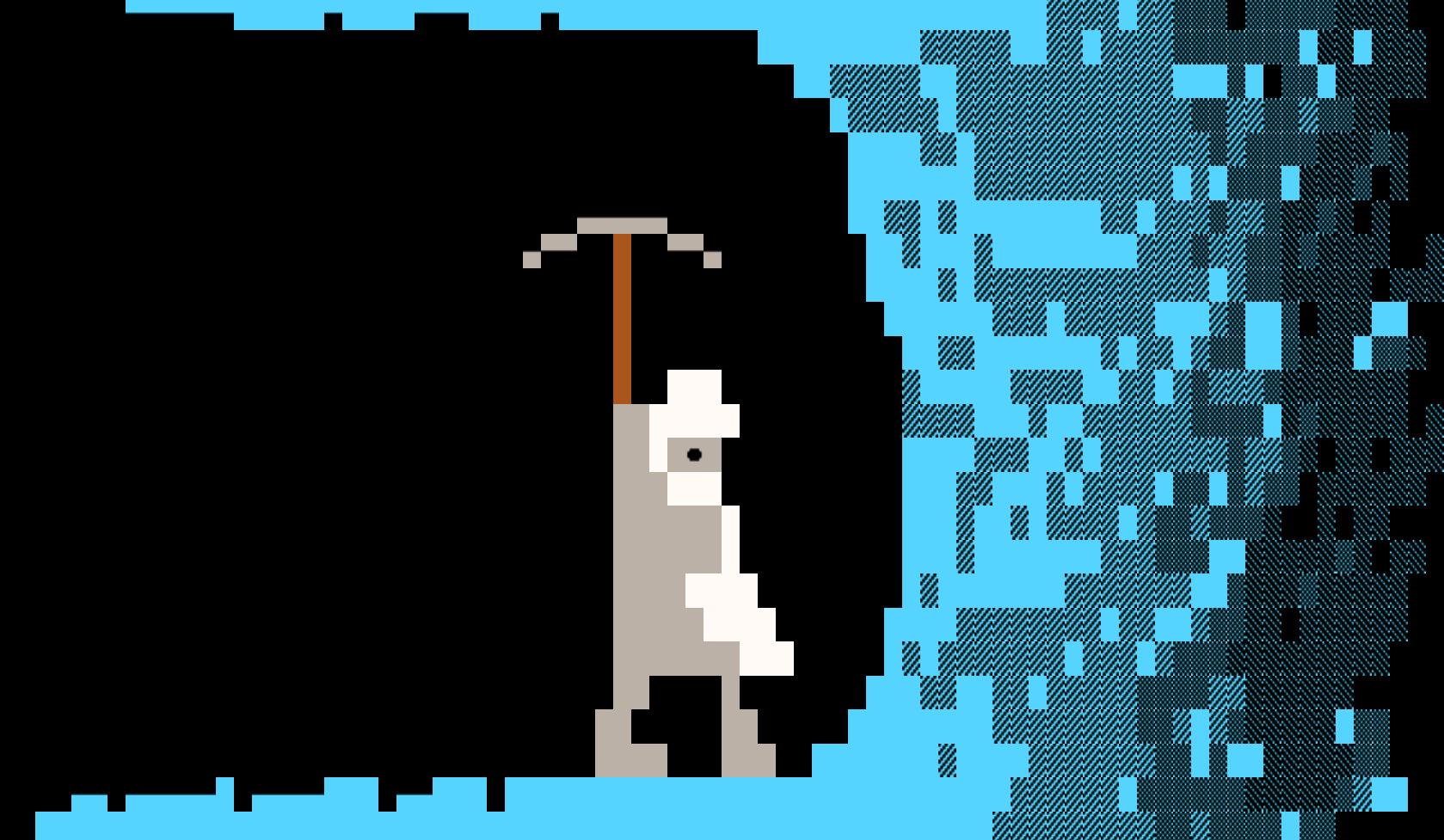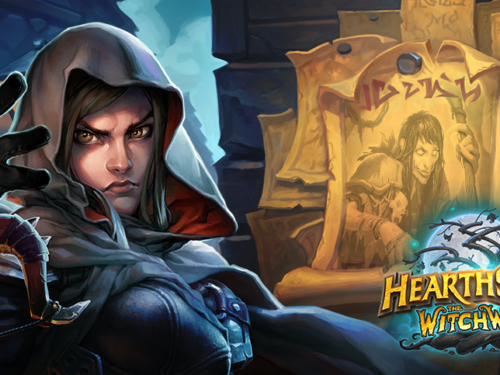Saying Dwarf Fortress is a great game isn’t exactly fair per se. It’s more of a simulation that allows players to intervene in a small part of a fantasy world that they generate from scratch. Everything from the internal organs and teeth of creatures, to the rise and fall of empires and their royal lineages is simulated. The death of a butterfly once destroyed an entire dwarf city.
Created entirely by programmer brothers Tarn and Zach Adams of Bay 12 Games, Dwarf Fortress was released in its alpha stage in 2006. It has since progressed, with each new feature surpassing the last and catapulting the game into an era of greater depth.
Graphics, interface and game modes
While unsurpassed in mechanical complexity, Dwarf Fortress sorely lacks visually. Everything in the base game is represented by font symbols, making it incredibly off-putting to the average gamer.
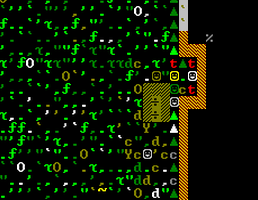
Luckily, the game’s cult fanbase has amended that issue, with the creation of alternative tilesets and companion programs that simulate the world in a 3D engine. The starter pack also makes improvements to the game’s UI, which is as inaccessible as the graphics by default.
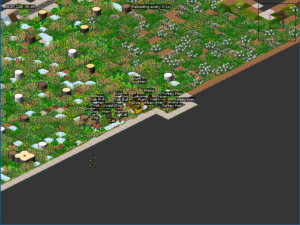
Struggling past the exterior, there are three different ways to “play” Dwarf Fortress. The first is Fortress Mode, which allows players to put together an expedition of dwarves to start a new settlement. Next, there’s Adventure Mode, where you’re given direct control of a single dwarf. Finally, there’s Legends Mode, where you can view the extensive history of the world you generated.
Adventure Mode is a roguelike and once finished, you can retire your adventurer with all the skills and items he’s acquired along the way. The best part is he might show up later in Fortress Mode as a new citizen, or go on to rule another settlement.
Legends lets you explore any event or follow the life of any creature or empire in the generated world. Watch heroes rise or monsters terrorize. Watch empires war with and conquer one another or fall from forces outside their control.
Basic gameplay and knowing the dwarf psyche
The majority of the game is text-based, so be ready to read going in. It’s very much about painting a picture of things in your own mind, rather than letting the game’s nearly non-existent graphics do the work.
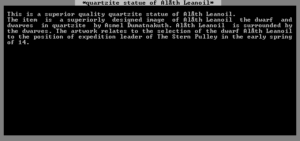
Fortress Mode seems to represent the game best, as you can issue general orders to your whole fortress, but you can never control your dwarves directly. You might instruct your dwarves to dig out a new room in your mountain fortress, but your miner would much rather spend the next 20 minutes getting drunk, seeing something he doesn’t like and then drowning himself in a river because he’s sad. Yikes.
To combat the chaotic nature of the dwarves’ whims, players can assign them specific jobs and elect managers to oversee things. This encourages dwarves a little, but you’re still at the mercy of your short, bearded citizens.
More often than not, dwarves will get around to doing whatever you tell them to, provided their needs are met. Thing is, they need food, social interaction, things to admire, a clean environment, safety and much, much more.
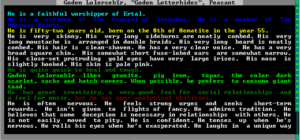
Each dwarf has a list of likes and dislikes. Being exposed to things on their lists affects their moods. A dwarf in a bad mood might spiral into a tantrum, potentially attacking other dwarves. They could also simply become depressed or begin stumbling around in a haze and into danger — off of a nearby cliff for example.
The game was designed in such a way that at times one disgruntled dwarf could trigger a “Tantrum Spiral” or “Loyalty Cascade.” This would involve your fortress basically becoming The Purge, with dwarves fighting and killing one another in a frenzy, while there’s nothing you can do but watch. All it would take is one dwarf in a bad mood to punch another, putting them in a bad mood as well. Fortunately, that was not an intended feature, but its a situation that still pops up in versions of the game.
Once your fortress is established, you’ll elect a mayor, who will want an office and a fancy room. When you’re more prosperous, you’ll start attracting or elevating dwarves to royalty, with their tastes increasing to match their standing.
These ruling class dwarves will also pass laws on occasion, such as forbidding the export of certain goods. Lawbreakers will often face “Dwarven Justice,” which usually involves being beaten close to death. Dwarves will often be taken by “Strange Moods,” which will infuse them with the need to create items of the highest quality, called Artifacts, and become a master in that craft.

These items range from insignificant trinkets that could be hoarded or sold to mighty weapons and armor of unparalleled quality. Most of the game’s craftable items can be made at Artifact quality, at which point they gain some special powers. Artifact doors, for example, are unbreakable, while an Artifact cage should be inescapable and can house any creature.
Threats and the world
Dwarf Fortress has many perils. As your fortress gains more value, it draws the attention of neighbors. Goblins, humans and elves will attack your fortress from time to time, though the latter two often do so as a response to poor diplomacy choices.
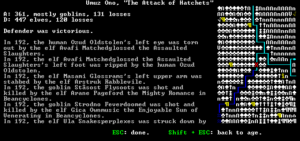
Migrants will arrive at your fortress every season to increase your population, but they sometimes bring vampires or werebeasts hidden in their midsts. Vampires, with their natural charisma, may even rise through the ranks and become the leader of your fortress, while werebeasts might systematically infect your entire population.
Forgotten beasts and megabeasts created during world generation roam both the surface and deep places of the world. If they stumble upon your fortress, or you stumble upon them while digging too deeply, you’ll be in for a fight.
The gods will sometimes bestow the gift of necromancy on the world and the bearers will construct a tower to practice the dark arts. Their secrets can be stolen in Adventure Mode and spread throughout the world. Just pray they don’t end up in the hands of the local dwarf butcher.
And somewhere in the world also lurks the darkest things of all: demons. To tell more would ruin the fun of the game, but know that they’re out there, plotting and manipulating the world around your innocent fortress.
Verdict
Dwarf Fortress is the most complex game ever made. What’s written here doesn’t even do it a shred of justice. But with that complexity comes difficulty rivaled by few others. You’ll likely need tutorials to accomplish even the most basic tasks at first.
Many fans have been known to enjoy the game completely vicariously, so a trip to the game’s official subreddit or the official forums could make for hours of entertainment. Even reading random pages of the game’s wiki proves to be a treat. You can also check out the tragic story of Boatmurdered, perhaps the most famous of all dwarven tales, to get a true sense of the Dwarf Fortress experience.
The best way to get started playing the game is to take advantage of the handy bundle of mods the game’s community has put together for new players: PeridexisErrant’s Starter Pack. It’s also free, as the game is entirely supported by donations.
Perhaps the most impressive thing about Dwarf Fortress isn’t what it is, but what it can become. The creators consider the game their life’s work. They’re currently working on adding a magic system to the game as well as ships and sailing. If this is what it looks like after 12 years, what will it look like in 20?
(Split Tooth may earn a commission from purchases made through affiliate links on our site.)

